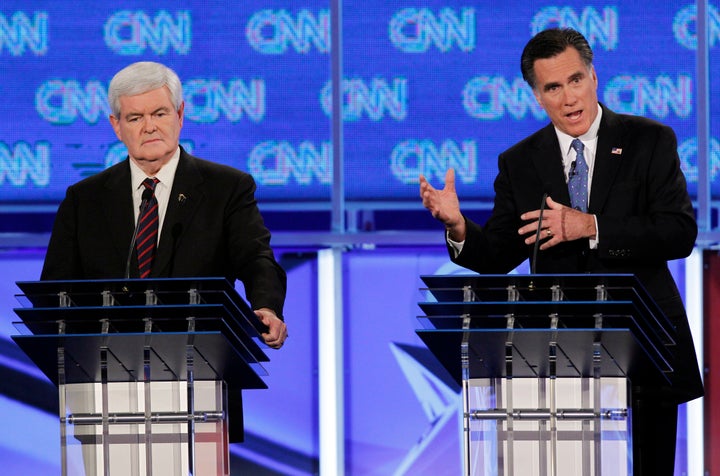
Most politicians would brush aside their mother if it meant scoring a photo-op with a Minnesota businessman like John Van Dine. His 22-year-old company, SAGE Electrochromics, is in the middle of a $150 million expansion to double its workforce to total 250, all in Fairbault, Minn., and pulling in a decent wage.
SAGE, which makes glass plates with electronic sensors that turn lighter or darker depending on the time of day, is even exporting products to Asia and the Middle East. But Van Dine isn't look to share the stage with any politician; he's just hoping for more government investment in infrastructure, education and health care, all needed for a sustained economic recovery, he said.
But as voters head to the caucuses and primaries on Tuesday in Minnesota, Colorado and Missouri, those aren't the kinds of initiatives making headlines. Instead, the leading Republican candidates are hammering home the idea that cuts to government spending and fewer regulations are key to an economic rebound.
"It's not that they are not aware of the problems; it is that they haven't provided the leadership," said Van Dine, adding that politicians in both parties are to blame for not having the courage to propose investing on a large scale to fuel economic growth.
Minnesota is in better shape than most of the rest of the country, including Colorado and Missouri. Unemployment is relatively low, at 5.7 percent. The state's manufacturing sector has seen 16 straight months of growth, according to the Minnesota Department of Economic Development.
Yet, according to the Bureau of Labor Statistics, job growth in Minnesota has been slow, amounting to a rate of just 1 percent in 2011 -- slightly higher than the national average. The state's manufacturers employ fewer workers than before the recession, and these types of jobs are unlikely to be fully restored to pre-2008 levels, said Troy Walters, an economist at IHS Global Insight.
In addition, Minnesota is experiencing cutbacks in government spending. There were 1.4 percent fewer government workers in this state by the end of 2011, compared with the tally at the end of 2010, according to the Bureau of Labor Statistics. Local government layoffs have hurt economic growth in the state, said Thomas Stinson, an applied economics professor at the University of Minnesota and an economist for the state. When workers in the public or private sector are laid off, they spend less, which then reduces employers' demand for workers -- hurting consumer demand even more, Stinson said. "It really starts a vicious circle."
Missouri and Colorado also lost government jobs last year, and Republican presidential candidates have made government job cuts part of their platforms. Former Massachusetts Gov. Mitt Romney wrote in his economic plan that if elected, he would slice the size of the federal workforce 10 percent and cap federal spending at just 20 percent of the U.S. gross domestic product, which would mean trimming federal spending about 17 percent.
Candidates Romney and Newt Gingrich have both said they would slash regulations, corporate taxes and government spending as a means of addressing America's economic woes. The campaigns for the two candidates did not immediately respond to requests for comment.
The other Tuesday primary states would love to be in Minnesota's position. The total number of jobs in Missouri declined 0.1 percent in 2011, according to the Bureau of Labor Statistics. And among all states, Missouri is the 15th most pessimistic about the economy, according to Gallup. Colorado's economy is doing better than Missouri's but is still not healthy. Many of its job gains last year came within the leisure and hospitality sectors, whose positions tend to be low paying.
Manufacturing in Missouri and Colorado is starting to rebound, however. Last year manufacturing in Missouri grew the most quickly of any sector -- attaining a 3.1 percent job growth rate, according to the Bureau of Labor Statistics. In Colorado, jobs in manufacturing, comprising less than 6 percent of its total, grew 0.7 percent last year.
Despite Minnesota's improving economic situation, Minnesotans are still very concerned about jobs and the economy, Stinson said. "If you haven't got a job, if you're worried about your job, the national debt is not what you're concerned about," he said.
While Republican candidates have mainly proposed cutting government spending and regulation, at a New Hampshire debate in January Gingrich mentioned that the United States should focus on developing its technological infrastructure. "You cannot compete with China in the long run if you have an inferior infrastructure. You've got to move to a 21st-century model. That means you've got to be technologically smart, and you have to make investments," the former U.S. House speaker said, according to the Daily Caller.
For his part, President Barack Obama said during his Jan. 24 State of the Union address that he would like to cut taxes for high-tech manufacturing companies that hire in the United States while establishing a minimum corporate tax rate.
But economists and labor leaders say rebuilding the economy takes more than incentives; it will require new investment. Damon Silvers, policy director at the AFL-CIO, estimated in January that the economy needs a $4 trillion public investment program over 10 years -- with spending focused on education and infrastructure -- to make the economy competitive enough to support the middle class.